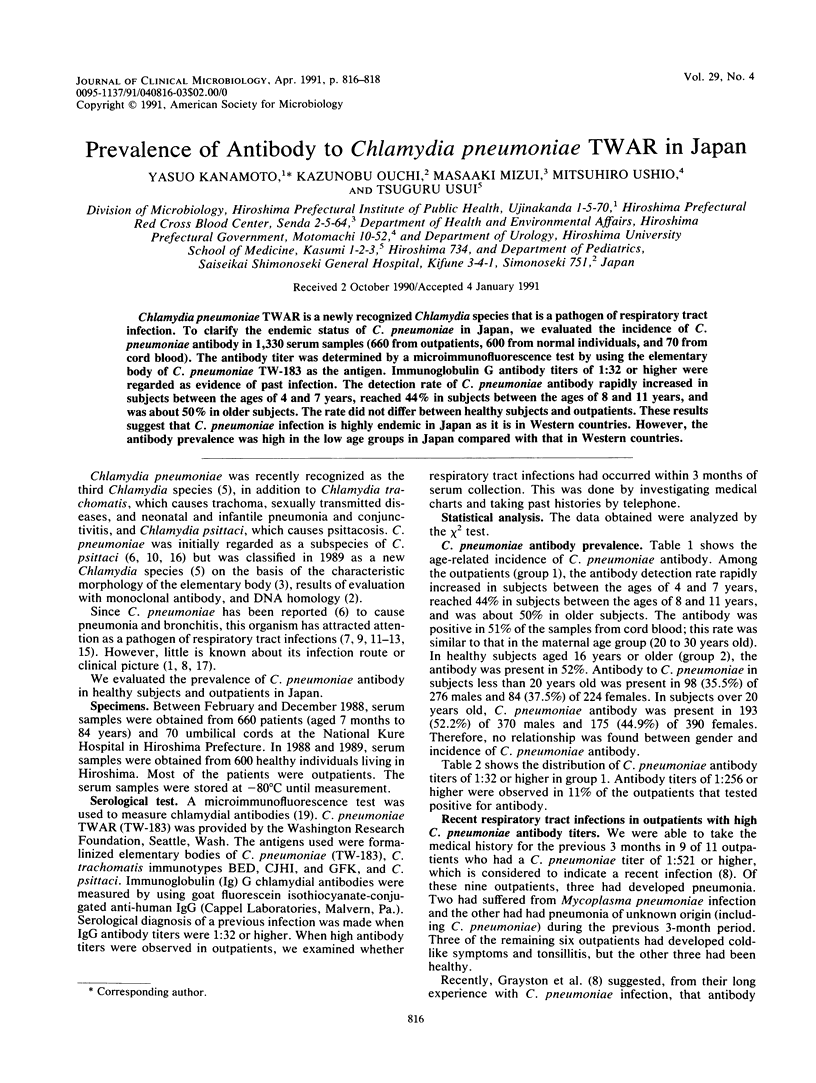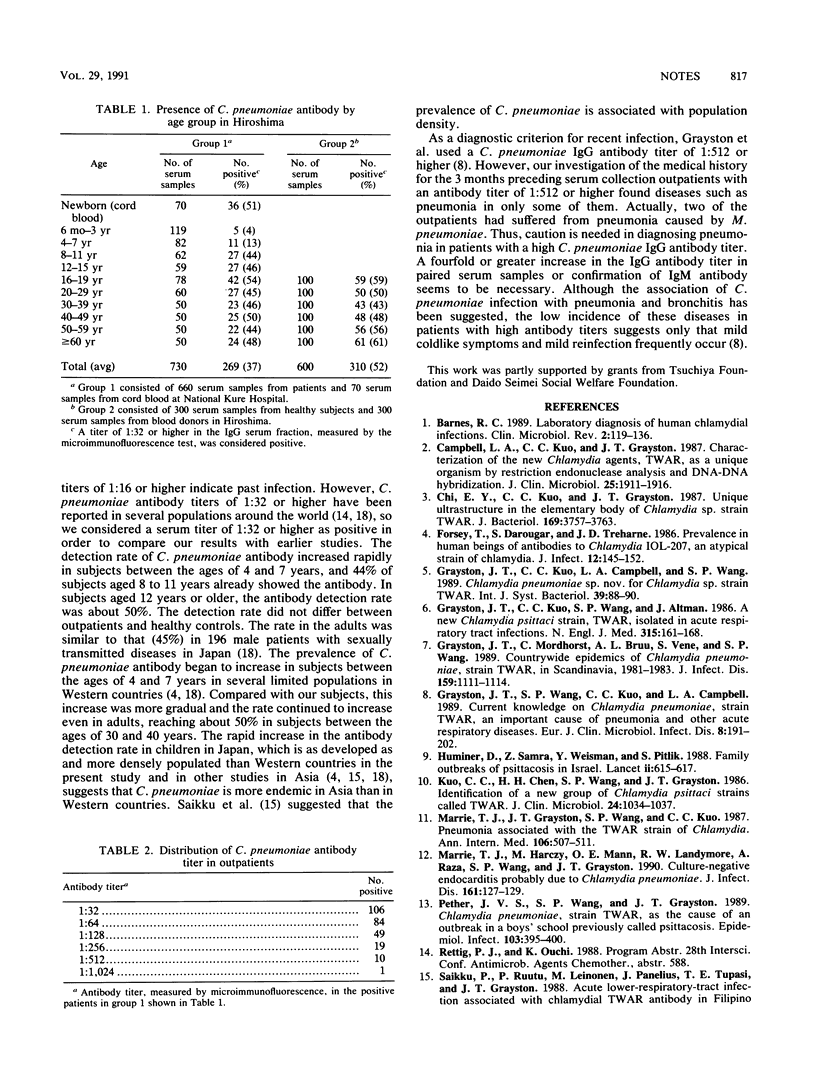Abstract
Chlamydia pneumoniae TWAR is a newly recognized Chlamydia species that is a pathogen of respiratory tract infection. To clarify the endemic status of C. pneumoniae in Japan, we evaluated the incidence of C. pneumoniae antibody in 1,330 serum samples (660 from outpatients, 600 from normal individuals, and 70 from cord blood). The antibody titer was determined by a microimmunofluorescence test by using the elementary body of C. pneumoniae TW-183 as the antigen. Immunoglobulin G antibody titers of 1:32 or higher were regarded as evidence of past infection. The detection rate of C. pneumoniae antibody rapidly increased in subjects between the ages of 4 and 7 years, reached 44% in subjects between the ages of 8 and 11 years, and was about 50% in older subjects. The rate did not differ between healthy subjects and outpatients. These results suggest that C. pneumoniae infection is highly endemic in Japan as it is in Western countries. However, the antibody prevalence was high in the low age groups in Japan compared with that in Western countries.
Full text
PDF


Selected References
These references are in PubMed. This may not be the complete list of references from this article.
- Barnes R. C. Laboratory diagnosis of human chlamydial infections. Clin Microbiol Rev. 1989 Apr;2(2):119–136. doi: 10.1128/cmr.2.2.119. [DOI] [PMC free article] [PubMed] [Google Scholar]
- Campbell L. A., Kuo C. C., Grayston J. T. Characterization of the new Chlamydia agent, TWAR, as a unique organism by restriction endonuclease analysis and DNA-DNA hybridization. J Clin Microbiol. 1987 Oct;25(10):1911–1916. doi: 10.1128/jcm.25.10.1911-1916.1987. [DOI] [PMC free article] [PubMed] [Google Scholar]
- Chi E. Y., Kuo C. C., Grayston J. T. Unique ultrastructure in the elementary body of Chlamydia sp. strain TWAR. J Bacteriol. 1987 Aug;169(8):3757–3763. doi: 10.1128/jb.169.8.3757-3763.1987. [DOI] [PMC free article] [PubMed] [Google Scholar]
- Forsey T., Darougar S., Treharne J. D. Prevalence in human beings of antibodies to Chlamydia IOL-207, an atypical strain of chlamydia. J Infect. 1986 Mar;12(2):145–152. doi: 10.1016/s0163-4453(86)93608-x. [DOI] [PubMed] [Google Scholar]
- Grayston J. T., Kuo C. C., Wang S. P., Altman J. A new Chlamydia psittaci strain, TWAR, isolated in acute respiratory tract infections. N Engl J Med. 1986 Jul 17;315(3):161–168. doi: 10.1056/NEJM198607173150305. [DOI] [PubMed] [Google Scholar]
- Grayston J. T., Mordhorst C., Bruu A. L., Vene S., Wang S. P. Countrywide epidemics of Chlamydia pneumoniae, strain TWAR, in Scandinavia, 1981-1983. J Infect Dis. 1989 Jun;159(6):1111–1114. doi: 10.1093/infdis/159.6.1111. [DOI] [PubMed] [Google Scholar]
- Grayston J. T., Wang S. P., Kuo C. C., Campbell L. A. Current knowledge on Chlamydia pneumoniae, strain TWAR, an important cause of pneumonia and other acute respiratory diseases. Eur J Clin Microbiol Infect Dis. 1989 Mar;8(3):191–202. doi: 10.1007/BF01965260. [DOI] [PubMed] [Google Scholar]
- Huminer D., Samra Z., Weisman Y., Pitlik S. Family outbreaks of psittacosis in Israel. Lancet. 1988 Sep 10;2(8611):615–618. doi: 10.1016/s0140-6736(88)90650-2. [DOI] [PubMed] [Google Scholar]
- Kuo C. C., Chen H. H., Wang S. P., Grayston J. T. Identification of a new group of Chlamydia psittaci strains called TWAR. J Clin Microbiol. 1986 Dec;24(6):1034–1037. doi: 10.1128/jcm.24.6.1034-1037.1986. [DOI] [PMC free article] [PubMed] [Google Scholar]
- Marrie T. J., Grayston J. T., Wang S. P., Kuo C. C. Pneumonia associated with the TWAR strain of Chlamydia. Ann Intern Med. 1987 Apr;106(4):507–511. doi: 10.7326/0003-4819-106-4-507. [DOI] [PubMed] [Google Scholar]
- Marrie T. J., Harczy M., Mann O. E., Landymore R. W., Raza A., Wang S. P., Grayston J. T. Culture-negative endocarditis probably due to Chlamydia pneumoniae. J Infect Dis. 1990 Jan;161(1):127–129. doi: 10.1093/infdis/161.1.127. [DOI] [PubMed] [Google Scholar]
- Pether J. V., Wang S. P., Grayston J. T. Chlamydia pneumoniae, strain TWAR, as the cause of an outbreak in a boys' school previously called psittacosis. Epidemiol Infect. 1989 Oct;103(2):395–400. doi: 10.1017/s0950268800030752. [DOI] [PMC free article] [PubMed] [Google Scholar]
- Saikku P., Wang S. P., Kleemola M., Brander E., Rusanen E., Grayston J. T. An epidemic of mild pneumonia due to an unusual strain of Chlamydia psittaci. J Infect Dis. 1985 May;151(5):832–839. doi: 10.1093/infdis/151.5.832. [DOI] [PubMed] [Google Scholar]
- Schachter J. Pathogenesis of chlamydial infections. Pathol Immunopathol Res. 1989;8(3-4):206–220. doi: 10.1159/000157149. [DOI] [PubMed] [Google Scholar]


